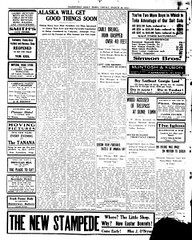
About UsThe Numismatic Bibliomania Society is a non-profit organization promoting numismatic literature. For more information please see our web site at coinbooks.org SubscriptionsThose wishing to become new E-Sylum subscribers (or wishing to Unsubscribe) can go to the following web page link MembershipThere is a membership application available on the web site Membership Application To join, print the application and return it with your check to the address printed on the application. Membership is only $15 to addresses in the U.S., $20 for First Class mail, and $25 elsewhere. For those without web access, write to: David M. Sundman, Secretary/TreasurerNumismatic Bibliomania
Society AsylumFor Asylum mailing address changes and other membership questions, contact David at this email address: dsundman@LittletonCoin.com SubmissionsTo submit items for publication in The E-Sylum, just Reply to this message, or write to the Editor at this address: whomren@coinlibrary.com
BUY THE BOOK BEFORE THE COINYou won't regret it! |
- WAYNE'S WORDS: THE E-SYLUM OCTOBER 14, 2012
- KOLBE & FANNING SALE 126 RESULTS
- SAVILLE TO OFFER CHRISTOPHER BLUNT LIBRARY
- NEW BOOKS: NOYES UNITED STATES LARGE CENTS VOLUMES 5 AND 6
- NEW BOOK: ABRAHAM LINCOLN: BEYOND THE AMERICAN ICON
- NEW BOOK: IN SEARCH OF ANCIENT AFGHANISTAN
- NEW BOOK: WORLD PAPER MONEY GENERAL ISSUES 1368-1960, 14TH EDITION
- NEW BOOK: 2013 COIN WORLD PRICE GUIDE
- BOOK REVIEW: THE HOLEY DOLLARS AND DUMPS OF PRINCE EDWARD ISLAND
- BOOK REVIEW: LE PESAGE MONÉTAIRE
- UPDATED ORDERING INFORMATION FOR THE SIAMESE COINS BOOK
- MORE ON CLYDE BARROW'S SILVER DOLLAR
- ALASKA LIBERTY HEAD TOKEN MATES FOUND
- NOTES FROM E-SYLUM READERS: OCTOBER 14, 2012
- NUMISMATIC VOCABULARY: POWDER METALLURGY
- RESEARCHER SEEKS FIRST LIST OF MEDALS FOR SALE BY U.S. MINT
- 1812, 1813 AND 1815 NAVAL MEDALS SOUGHT FOR EXHIBIT
- OCTOBER 2012 CUBAN NUMISMATIC ASSOCIATION NEWSLETTER PUBLISHED
- WAYNE'S NUMISMATIC DIARY: OCTOBER 14, 2012
- MORE ON WASHINGTON BEFORE BOSTON DIE VARIETY RESEARCH
- BRITISH MUSEUM VOLUNTEERS PHOTOGRAPH AMERICAN COINS AND MEDALS
- EXHIBIT: THE MEDALLIC ART OF JOÃO DUARTE
- FUNDING THE WAR OF 1812
- SOME NEW COIN ISSUES: OCTOBER 14, 2012
- KEY THALER FIGURES: ARCHDUKE SIGISMUND AND BERNHARD BEHEIM
- MARTIN PURDY ON THE HO HI WHANG TOKEN MYSTERY
- COPYRIGHT AND THE NEW ZEALAND HOBBIT COINS
- LARGE BATCH OF NEW $100 BILLS STOLEN
- AN ABANDONED ATTIC FULL OF BOOKS
- FEATURED WEB SITE: TOKENCATALOG.COM
WAYNE'S WORDS: THE E-SYLUM OCTOBER 14, 2012

New subscribers this week include Jon McDaniel and Ken Aring. Welcome aboard! We have 1,595 email subscribers, plus 194 followers on Facebook.
This week we open with a report on results from the recent Kolbe-Fanning numismatic literature sale, and an update from Douglas Saville, who recently purchased a major numismatic library. Next up are five new books and reviews of Chris Faulkner's book on the Prince Edward Island Holey Dollars and a new book on French coin weights and scales.
Other topics include powdered metallurgy, Cuban numismatics, the British Museum's holdings of American coins and medals, the medallic art of João Duarte and copyrighted images on legal tender coins.
To learn more about David Proskey’s annotated copy of Haseltine, Clyde Barrow's "Death Car Coin", die sinker E. R. Williamson of Minneapolis, George Washington's Patowmack Company, gundalows, gorgets, bugs, snakes, toads and snails, read on. Have a great week, everyone!
Wayne Homren
Editor, The E-Sylum
KOLBE & FANNING SALE 126 RESULTS
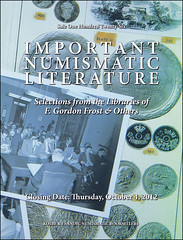 Kolbe & Fanning Numismatic Booksellers held their 126th sale of important numismatic literature from around the world on October 4. The 1092-lot sale featured material from several different consignors, including a significant number of lots from the library of the late F. Gordon Frost. The Frost consignment featured an important offering of classic 19th- and early 20th-century American numismatic auction catalogues, including a number of rarities. Works on ancient and foreign numismatics were also offered, with special sections devoted to specialized works on British tokens and Russian numismatics.
Kolbe & Fanning Numismatic Booksellers held their 126th sale of important numismatic literature from around the world on October 4. The 1092-lot sale featured material from several different consignors, including a significant number of lots from the library of the late F. Gordon Frost. The Frost consignment featured an important offering of classic 19th- and early 20th-century American numismatic auction catalogues, including a number of rarities. Works on ancient and foreign numismatics were also offered, with special sections devoted to specialized works on British tokens and Russian numismatics.
The sale results were good, with strong competition being encountered for the early U.S. catalogues in particular. The prices realized list was posted to the Kolbe & Fanning website within 24 hours of the sale’s close, from which it can be downloaded at www.numislit.com.
A few notable lots are as follows:
A fine, plated example of W. Elliot Woodward’s important "All the Kingdoms of the World" sale, featuring his personal collection, sold for $1840 (all prices included the 15% buyer’s premium).
David Proskey’s heavily annotated copy of Haseltine’s 1876 work on Confederate currency sold for $1437.50 on a bid reduced by more than half.
A bound volume of 19th-century U.S. auction catalogues, including four with plates, sold for $1092.50.
A plated copy of W. Elliot Woodward’s 71st sold for $977.50 on a $200 estimate.
Woodward’s very rare Sale 76 sold for $977.50 on a $150 estimate. This appears to have been the first solo offering of this catalogue in about four decades.
Works on ancient and foreign coins also brought strong prices, led by a nearly complete set of the American Numismatic Society’s Numismatic Notes and Monographs series, which sold for $5175.
A fine priced and named copy of the very rare 1755 sale of the Richard Mead collection sold for $1725 after very heavy competition, on what proved to be a very conservative $300 estimate.
An interleaved, original Dalton & Hamer brought $1265.
A fine copy of the quarter morocco edition of the 1990 reprint of Dalton & Hamer brought $1150.
Providing further proof that a book need not be old to be in demand, a copy of Biaggi’s 1992 work on medieval Italian coins brought $833.75.
Printed catalogues were sent to active bidders on our mailing list. A limited number remain and are available for purchase at $15 postpaid ($20 outside the U.S.).
Kolbe & Fanning are still accepting consignments of important numismatic books for our January 12, 2013 public auction at the Waldorf-Astoria Hotel in New York City, held in conjunction with the New York International Numismatic Convention. Interested consignors should contact the Kolbe & Fanning office as soon as possible to discuss including items in this significant sale.
Kolbe & Fanning Numismatic Booksellers
141 W. Johnstown Road
Gahanna, OH 43230
(614) 414-0855
df@numislit.com
www.numislit.com
SAVILLE TO OFFER CHRISTOPHER BLUNT LIBRARY

I am delighted to announce that I have purchased the major part of the numismatic library of the eminent British numismatist Christopher Blunt (1904-1987).
"Few can have made a more wide-ranging contribution to their chosen field of historical study than Christopher Blunt did to British numismatics". Thus began Ian Stewart’s (now Lord Stewartby) masterful obituary of Christopher Blunt published in the Proceedings of the British Academy 76, pp. 347-381.
Christopher Blunt is beyond question the greatest figure of the 20th century in the study of British coinage. From January 1918, when he first started at Marlborough School, his friendship with John Shirley and Harry Earle Fox, encouraged him to start to form a library of books and catalogues. The Fox brothers were the leading coin-collectors of their day, specializing in the Edwardian penny coinage from 1279 to 1344, and in 1939 Shirley Fox bequeathed his important collection to Blunt.
Christopher Blunt’s interest in the provenance of coins is reflected in his outstanding library of auction sale catalogues, mostly annotated with prices and buyers’ names, and going back to the early years of the 18th century is the main focus of the library. In addition, most of the standard works on British coins are present, and one of his copies of Ruding’s "Annals of the Coinage" is inscribed "To Christopher Blunt. J. Shirley Fox, Marlborough, 1923".
Douglas adds:
The library is of course very strong in early British numismatic auction sales catalogues and has many of the standard works relating to the subject. Enquiries from any interested subscriber to The E-Sylum would be welcome. I doubt a catalogue of the library will be produced.
To visit Douglas' web site, see: www.douglassaville.com
NEW BOOKS: NOYES UNITED STATES LARGE CENTS VOLUMES 5 AND 6
Bill Noyes has recently added to his books illustrating the die varieties of large cents from 1793 to 1857. The new books are United States Large Cents, Volume 5, 1816 to 1845, and Volume 6, 1846 to 1857. These join Volumes 1 and 2, previously issued, which covered the 1793 to 1797 period. Unlike the previous books, these do not offer a detailed condition census of each variety, but are more concerned with the attribution of varieties and die states through the use of color photographs. Both have maroon covers, matching the earlier volumes.
In the 1816-1839 period, a typical variety is illustrated at greater than 2X, and the characteristics of each die are described and marked around the photos. Then the die states, the changes the coins undergo as the dies wear and crack, are described and generally illustrated, again with color photos greater than life size. The recently (re)discovered 1825 N5 is included. This period was previously covered by Newcomb, Wright, and Noyes himself, but the treatment of die states is expanded, with obverse and reverse states individually stated.
For the 1840-1857 period, Noyes has employed a different approach. Rather than listing a series of numbers relating the digits of the date to the bust and denticles, as done by Reiver and Grellman, he has photographed the date, in each case, and placed a photo, 5X or larger, below the obverse and reverse photographs. This shows the date and surrounding features, similar to a coin being viewed with a low power glass. Below that are photos of the important characteristics of each variety, and descriptions of die states in which the varieties are found.
Because many of the variations are quite subtle, red arrows and/or lines are used to enhance some of the fainter variations. Typically each variety is covered in a single page, and all illustrations are color photographs: the overall coin, the date area, and other areas characteristic of the particular variety.
At the beginning of each volume are a number of pages containing quick finders, or listings of defining characteristics of varieties, die links, which are lists of dies which are used in more than one variety, and other information, such as the original Newcomb position descriptions. These would probably have been more useful as booklets to use alongside the individual pages, and it is suggested that the reader make his own booklet using a copier. Ripping the pages from the binding is strongly discouraged.
The volumes were divided between 1845 and 1846, rather than 1839 and 1840. This was done to keep the size of each volume approximately the same, and is of little consequence. The books are not available individually. Another factor is that the varieties of the early 1840s are relatively few in number for each date, and those of the late 1840s and 1850s increase as do the mintages.
The books are offered as a pair only at $225.00 plus $10.00 shipping and are available from the sole distributor Charles Davis, Box 547, Wenham, MA 01984. Numislit@aol.com or on his website numisbook.com at $235.00 plus $10.00 shipping.
NEW BOOK: ABRAHAM LINCOLN: BEYOND THE AMERICAN ICON
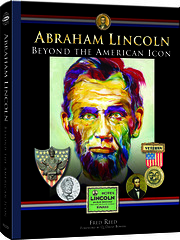 Whitman Publishing is releasing a new book by award-winning author Fred Reed in time for the holidays. Abraham Lincoln: Beyond the American Icon, a 464-page hardcover volume, retails for $29.95 and will be available from booksellers and hobby shops nationwide on November 19, 2012, the 149th anniversary of Lincoln’s famous Gettysburg Address. It can also be pre-ordered online, including at www.Whitman.com. The book is a sequel to Reed’s best-selling Abraham Lincoln: The Image of His Greatness.
Whitman Publishing is releasing a new book by award-winning author Fred Reed in time for the holidays. Abraham Lincoln: Beyond the American Icon, a 464-page hardcover volume, retails for $29.95 and will be available from booksellers and hobby shops nationwide on November 19, 2012, the 149th anniversary of Lincoln’s famous Gettysburg Address. It can also be pre-ordered online, including at www.Whitman.com. The book is a sequel to Reed’s best-selling Abraham Lincoln: The Image of His Greatness.
In 2009 the United States—and the world—celebrated the bicentennial of Abraham Lincoln's birth. Reed's book Abraham Lincoln: The Image of His Greatness was part of that celebration, chronicling America’s fascination with our homespun sixteenth president.
Now, in Abraham Lincoln: Beyond the American Icon, Reed continues his exploration of the ever-changing popular depiction of Lincoln—the idealized, the idolized, the iconic—the man and the myth—bringing our understanding up to the present day.
More than 1,400 images, both famous and obscure, show Lincoln on coins, tokens, medals, stamps, stocks, bonds, and paper money—as well as paintings, sculptures, magazine covers, advertisements, cartoons, movie stills, and other diverse media.
"Fred Reed's narrative is engaging and thought-provoking," said Whitman publisher Dennis Tucker. "His illustrations range from the legendary to some that have never been published. They show us how we Americans have seen our most honored president, how that vision has changed over the years, and what it says about our great nation."
Abraham Lincoln: Beyond the American Icon ∙ By Fred Reed; foreword by Q. David Bowers 464 pages, hardcover, 8.5 x 11 inches, full color ∙ Retail $29.95 ∙ ISBN 0794837417
"Fred Reed is one of the very best numismatic writers going. He combines encyclopedic knowledge with a real flair for the written word—there aren’t many people who possess both kinds of talent."
—Dr. Richard Doty, senior curator, National Numismatic Collection, Smithsonian Institution
"I am an admirer of Reed's work and I believe that it adds a unique perspective to Lincoln scholarship."
—Dr. Thomas R. Turner, longtime editor-in-chief of the Lincoln Herald
"With compelling analysis and an unmatched collection of images, Fred Reed bridges the gap between numismatics and mainstream Lincoln research. His new book will delight readers in both camps."
—Q. David Bowers, chairman emeritus, Stack's Bowers Galleries
NEW BOOK: IN SEARCH OF ANCIENT AFGHANISTAN
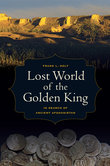 A UH history professor explores the story behind an ancient civilization in his new book, "Lost World of the Golden King: In Search of Ancient Afghanistan."
A UH history professor explores the story behind an ancient civilization in his new book, "Lost World of the Golden King: In Search of Ancient Afghanistan."
In the book, professor Frank Holt explains cognitive numismatics — understanding the civilization's language based on its coins.
Holt said cognitive numismatics helped him develop a story covering two centuries of Bactria history, beginning with the colonization by remnants of Alexander the Great’s army and ending with the kingdom’s collapse after a series of nomadic invasions.
"I think of the coin as the original data disk," Holt said. "Instead of studying the Kings and Queens, I studied the people who actually crafted the coin. The coin shows mistakes the Greeks made that betrayed their identity."
"Lost World" describes how newly unearthed archaeological evidence and the language behind the Greek coin contributed to the rediscovery of 18th and 19th century Afghanistan. The methodologies of numismatics and historical writings of the 20th century led to the discovery of one city out of the thousands that have been discovered, revealing buildings, a temple and a treasury.
"Dr. Holt is an amazing colleague," said Associate Professor Raul Ramos, director of undergraduate studies. "With history, everyone writes and studies different time periods, and Holt has made the ancient world accessible to others."
Holt has studied history for more than 30 years, traveling to see museum collections in places such as Athens, London and New York, he said.
In 2007, Holt attended a conference in Paris that inspired him to write the book.
"There are two things readers should keep in mind," Ramos said. "The first — Dr. Holt told a story never told. The second is he is very thoughtful about his methodology. He does not take the study for face value, and people could learn a lot from his methodology."
The difficulty with studying this time period is that few documents remain that can chronicle it, Ramos said.
Holt got around this problem by studying the culture’s coins, he said.
"I want people to understand and love the detective work behind ancient Greek history," Holt said. "It is mind-boggling to understand how these cultures interact and how it is very relevant with today and our society."
Holt’s book is available at local bookstores and online retailers.
To read the complete article, see: Professor unveils book on Ancient Afghanistan (hedailycougar.com/2012/10/10/professor-unveils-book-on-ancient-afghanistan/)
To order a copy of the book see: Lost World of the Golden King (ww.ucpress.edu/book.php?isbn=9780520273429)
NEW BOOK: WORLD PAPER MONEY GENERAL ISSUES 1368-1960, 14TH EDITION
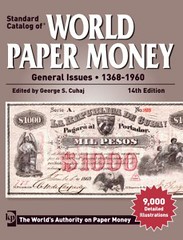 A new edition of the Standard Catalog of World Paper Money General Issues 1368-1960 is now available from Krause Publications.
A new edition of the Standard Catalog of World Paper Money General Issues 1368-1960 is now available from Krause Publications.
This 14th edition is the definitive resource on circulating world paper money from 14th century China to the mid 20th century. Extensively illustrated, it includes numerous varieties and specimen notes.
All circulating paper money of the world from 1368 to 1960 is included with full descriptions and up-to-date pricing.
Features:
- 6,500 images for easy identification
- 50,000 accurate price listings
- No. 1 paper money reference book in the world
Editor George Cuhaj is an experienced and accomplished numismatist and researcher. George is a collector with a passion for this hobby, as well as several others. George, a former cataloger for both Stack's Auction House in New York and the American Numismatic Society, offers a wealth of knowledge to the KP line. George continues to develop his network of over 175 dedicated contributors.
For more information visit:
www.sellcoinbooks.com/new-releases/standard-catalog-of-
world-paper-money-general-issues-1368-1960-14th-edition
NEW BOOK: 2013 COIN WORLD PRICE GUIDE
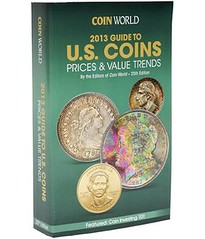 This little paperback is packed with a lot of information. The 2013 Coin World Price Guide features more than 40,000 values in as many as 20 different grades for all U.S. coin series.
This little paperback is packed with a lot of information. The 2013 Coin World Price Guide features more than 40,000 values in as many as 20 different grades for all U.S. coin series.
In the Coin World Price Guide, the Coin World editors present in an easy-to-use format a wealth of information and insights. Along with retail values there is technical information for each coin series including size, weight, composition and specific gravity.
The 25th edition of this classic compendium also features a special chapter on "Coin Investing 101" and a comprehensive analysis of the rare coin market written by Coin World Editor Steve Roach. Get all this and more for just $6.99!
The 2013 Coin World Price Guide provides a wealth of information and insight with more than 40,000 values in as many as 20 different grades for all U.S. coin series.
Technical information is also provided within the valuing section for each coin series including size, weight, composition and specific gravity. There are also chapters on mintages, Proof and Uncirculated Mint sets and commemorative coins. Information is also provided on grading, storage and preservation and U.S. coinage history. This year’s special feature article is on Coin Investing 101.
For more information, or to order, see: 2013 Coin World Price Guide (www.coinworld.com/dealers/amos-press/2013-coin-world-price-guide/)
BOOK REVIEW: THE HOLEY DOLLARS AND DUMPS OF PRINCE EDWARD ISLAND
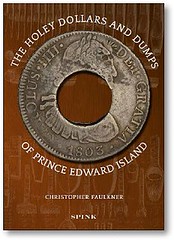 I just got back from Montreal.....while there, I got my copy of Chris Faulkner's new book "The Holey Dollars and Dumps of Prince Edward Island." Warren Baker brought it back from Toronto, where the first copies were available and Chris was there at the "premiere" of the book in North America. I understand Charlie Davis will be the US distributer for the book.
I just got back from Montreal.....while there, I got my copy of Chris Faulkner's new book "The Holey Dollars and Dumps of Prince Edward Island." Warren Baker brought it back from Toronto, where the first copies were available and Chris was there at the "premiere" of the book in North America. I understand Charlie Davis will be the US distributer for the book.
This is a magnificent work !!!!!!!!!! 220 x 305 mm brown cloth, gilt with decorative dust jacket. 382 pages, fully illustrated, with listings of all known examples of dollars and dumps. This book wonderfully weaves the dollars and dumps, with a history of them and their origins and a history of their use and illustrations of the decree that started the process and of merchants and illustrations of possible instruments used in the cutting and marking of the pieces. The front and rear pastedowns are illustrated with these. This is just a wonderful production....and kudos go to Chris !!!! (I do admit to prejudice in this matter as Chris is a friend of mine!!)
Hopefully Charlie will get his allotment of this book soon , which is published by Spink of London, with a grant from the J. Douglas Ferguson Historical Research Foundation. I do not know what the price will be, but whatever the price, it is worth it!!
To read the earlier E-Sylum article, see: NEW BOOK: HOLEY DOLLARS AND DUMPS OF PRINCE EDWARD ISLAND (www.coinbooks.org/esylum_v15n39a05.html)
BOOK REVIEW: LE PESAGE MONÉTAIRE
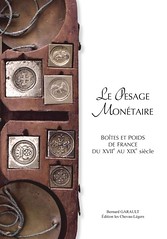 Garault, Bernard. Le pesage monétaire – Boîtes et poids de France du XVIIIe au XIXe siècle. Paris: Les Éditions Cheveau-Légers, 2012.
Garault, Bernard. Le pesage monétaire – Boîtes et poids de France du XVIIIe au XIXe siècle. Paris: Les Éditions Cheveau-Légers, 2012.
French language, with English and German introduction. Soft bound; 14.8 × 21.0 cm; illustrations in colour and black and white; 372 pages. ISBN 978-2-916996-47-9. Price: 29 euro.
The weighing of coins – Boxes and weights of 17th- and 19th-century France is a one-volume reference on the subject that is divided in two parts: the first is Garault’s original research and, the second, is a reprint of A. Dieudonné’s 1925 Manuel des poids monétaires (Handbook of coin weights)
Garault’s work is the result of 25 years of collecting and research. As the title indicates, it takes us through the world of scales made and used in France to weigh coins from the 17th to the 19th century. He describes in great detail and illustrates the scales, weights, and their boxes (including those used when the metric system was introduced) and touches on the various French scale makers.
Dieudonné’s 1925 work, still valid today, first speaks of the theory and doctrine of coin weights, such as their various uses (during coining and in commerce). Then he proceeds to catalogue the coin weights of France, Great Britain, Portugal, Spain, the Netherlands, the Rhine region, Italy, and central Europe.
It is a worthwhile addition to the library of those interested in the subject. My rating, because it is highly specialized, 4/5. It is available from www.cgb.fr .
UPDATED ORDERING INFORMATION FOR THE SIAMESE COINS BOOK
 I have learned that it will not be practical for me to handle the book
SIAMESE COINS FROM FUNAN TO THE FIFTH REIGN. If you have prepaid or
ordered other things to piggyback with it, I will contact you shortly
I have learned that it will not be practical for me to handle the book
SIAMESE COINS FROM FUNAN TO THE FIFTH REIGN. If you have prepaid or
ordered other things to piggyback with it, I will contact you shortly
The GOOD news is, a supply should reach the U.S. later this month, so there will be retailers offering it. The U.S. list price is $100, and I expect offers to be in the $90-$100 range. It's an EXCELLENT book and well worth the price, so I strongly urge you to follow through and obtain the book before its short print run sells out.
You can find out who's got it and compare prices by going to www.addall.com/Used/
TITLE: Siamese Coins
Author: Mihailovs
Author: Krisadaolarn
Author: Lesnichenko
Important: Run the search three times, once with each author. Some listers mis-spell the names.
If I have any updates on availability or prices, I will post that information under my description of the book here.
I suggest NOT ordering from AmazonCA (Canada). They don't have it in stock, and Amazon US will likely be a similar price. AmazonUK has an amazing $67 price - if you order it there, let me know if they actually ship.
http://www.CoinCoin.com
Scott Semans
P.O. Box 2347
Issaquah, WA 98027 USA
425-369-1725
8AM-7PM best
To read the earlier E-Sylum article, see: BOOK REVIEW: SIAMESE COINS, FROM FUNAN TO THE FIFTH REIGN (www.coinbooks.org/esylum_v15n41a07.html)
THE BOOK BAZARRE
MORE ON CLYDE BARROW'S SILVER DOLLAR
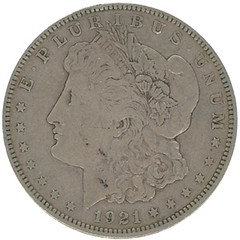
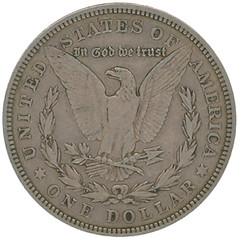
A 1921 Morgan silver dollar recovered by posse member Ted Hinton, removed from Clyde Barrow’s dark blue blazer which was in the car, shortly after the ambush which ended Barrow’s and Bonnie Parker’s lives in 1934.
Accompanied by a letter from Hinton's son, Linton J. 'Boots' Hinton stating "Among the many things that he retrieved from the car was Barrow’s jacket…In the pocket of the jacket were two silver dollar coins, both of which were retained by my father. I was aware that my father had a 1921 Morgan silver dollar which he kept in his "coin box". I was not aware that he had two until the day he took them out to tell me the story of how he got them. The coins were kept locked in a his "coin box" until it was sold by him in 1946…Nothing has ever been mentioned, written, or published about Clyde's jacket being in the car right after the melee that morning. Only Ted and the other five posse members were aware of the jacket…I was later made aware of the jacket."
Also accompanied by a letter of provenance from Michael Kozlin detailing the sale of the coin from Ted Hinton to a Dallas antique dealer in 1946. This antique dealer later crossed reputed mobster Paulie Castellano over an outstanding debt, and relinquished the coin (and his other valuables) to settle the debt, and explained the background of the coin to Castellano. In 1966, the letter writer’s grandfather, Armand Castellano, convicted bank robbery get-away car driver in 1930 (and Paulie’s cousin) was given the coin by Paulie as a razz. The coin was passed on from Armand to Kozlin in 1986, who then contacted Hinton who confirmed the details of the origin of the coin from Barrow’s jacket pocket.
Provenance: Clyde Barrow, Ted Hinton, M. Ross, Paul Castellano, Armand J. Castellano, Michael Kozlin
To read the complete lot description, see: Item 26 - Clyde Barrow Death Car Coin (www.rrauction.com/past_auction_item.cfm?ID=3271509)
To read the earlier E-Sylum article, see: BONNIE AND CLYDE MORGAN DOLLAR BRINGS $32,400 (www.coinbooks.org/esylum_v15n42a21.html)
ALASKA LIBERTY HEAD TOKEN MATES FOUND
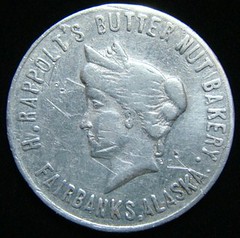
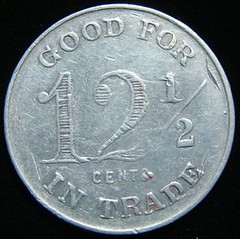
Alan V. Weinberg writes:
I immediately recognized the Rappolt's Bakery token from Fairbanks Alaska when I spotted it on its first day listing on eBay. There is a very similar Helena Bar Helena Montana token 12 1/2c token using the same Liberty Head hub and similar reverse denomination design. Both tokens were made by ER Williamson Minneapolis MN diesinkers, the Helena token being actually signed in tiny letters. I also recall another identical Liberty Head used on another token but cannot immediately bring it to mind. The Fairbanks AK bakery token, notwithstanding some questions about its legitimacy raised due to its unusual design , sold on eBay for $2183. today 10/11. I was the immediate underbidder.
That's the great thing about tokens. There's always a new design right around the corner - unique new tokens are discovered almost on a daily basis. Most people don't realize that Russ Rulau's telephone book-size reference on US tokens lists far less than 1 percent of all known old American tokens - so a hyped so-called "Rulau-unlisted" token means very little. You don't have that with coins where a newly discovered US coin surfaces perhaps once a decade or more.
The bakery was on Second Avenue according to a March 29th, 1912 page 4 advertisement in the Fairbanks Daily Times.
To read the ad online, see: http://newspaperarchive.com/fairbanks-daily-times/1912-03-29/page-4/
David Gladfelter writes:
It appears on the advertising tokens of E. R. Williamson, a die sinker of Minneapolis. Ronald J. Benice lists Henry Rappolt’s bakery and restaurant as being in business in Fairbanks from 1907 to 1916, and thereafter in Nenana. Only one Rappolt token from Fairbanks is listed by Benice (different from the one that Dick Hanscom shows) and none from Nenana, so the eBay token should bring a strong price.
I have notes on Williamson from Dick Grinolds: "Probably the earliest Minneapolis die sinker; I’m positive that they did all the early 2½ aluminum tokens that are the basic Minneapolis trade tokens from the 1890-1910 period; they also did work for merchants from other states as I have a PA token and a MT token signed by Williamson (both pictorials); they also probably most of the early pictorials from Minneapolis" Williamson is not listed in Rulau’s Standard Catalog of United States Tokens, 1700-1900.
John Mutch writes:
The Liberty Head design from Alaska looks to me to be a slight rework of some Minnesota and wisconsin tokens as pictured on Richard Greever's site, www.tokencatalog.com - the last one pictured below is from my collection (sorry for the rough condition), but it is from the maker, the E. R. Williamson Co. of Minneapolis. I haven't tried to do PhotoShop overlays of the various pieces to prove my theory, but a cursory look says the Liberty Heads are similar. Richard's site is proving to be invaluable in token research!
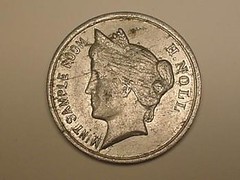
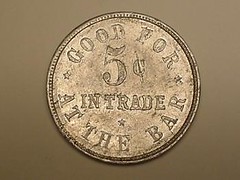
MINT SAMPLE ROOM / H. NOLL, La Crosse, Wisconsin
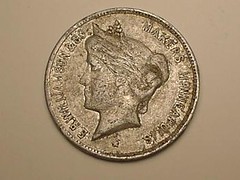
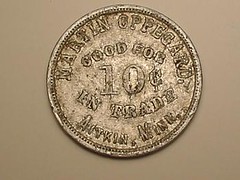 MARTIN OPPEGARD, Aitkin, Minnesota
MARTIN OPPEGARD, Aitkin, Minnesota
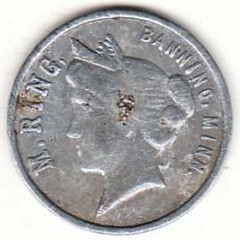
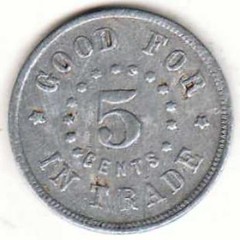 M. RING, Banning, Minnesota
M. RING, Banning, Minnesota

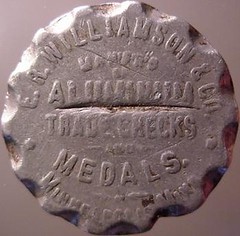 E.R. WILLIAMSON, Minneapolis, Minnesota
E.R. WILLIAMSON, Minneapolis, Minnesota
Dick Hanscom writes:
Thanks very much. The E-Sylum comes thru again! I also heard directly from Jerry Adams. Looks like I have an article for the newsletter, perhaps the first for 2013 – the 35th year!
To read the earlier E-Sylum article, see: QUERY: HAS ANYONE SEEN THIS LIBERTY HEAD DESIGN? (www.coinbooks.org/esylum_v15n42a18.html)
NOTES FROM E-SYLUM READERS: OCTOBER 14, 2012
Alaska Gold Rush: Correction to Who Published First
Donn Pearlman writes:
The E-Sylum article about the First National Bank of Fairbanks $5 note (E-Sylum, Vol. 15, Number 42, October 7, 2012), gave indicated that the Associated Press picked up the (original) story from the Fairbanks Daily News-Miner newspaper (which a letter writer humorously titled the Bairflanks Daily-Newsless Miner). However, for the record, it was the other way around. Working with Heritage Auctions, AP had the story exclusively first and it was subsequently picked up by other news media, including the Fairbanks paper.
United Press International and other news media also did stories based on a news release from Heritage Auctions that was distributed to news media after the AP story broke. At one point, more than 2,000 web sites in the USA, Canada and other countries had stories or blog items about the note.
To read the first article based on Heritage's information, see: Rare century-old $5 Alaska bill to be auctioned (news.yahoo.com/rare-century-old-5-alaska-bill-auctioned-070448123--finance.html;_ylt=A2KJjagl2XJQSgQA4EjQtDMD)
To read the earlier E-Sylum article, see: ALASKA NATIONAL BANK NOTE MAKES HEADLINES (www.coinbooks.org/esylum_v15n42a22.html)
Correction to the Kikokuniya Website Address
Joe Boling writes:
Well, I am embarrassed. I included a typo in the correction I sent about the Kinokuniya website. I spelled it correctly the first time out, and misspelled it at the second mention, and Wayne picked up the misspelling for the title of the correction. Thoroughly confusing for anyone not familiar with Japanese publishers, I'm sure. Try them all - eventually one will bring you to the correct website.
To read the earlier E-Sylum article, see: NOTES FROM E-SYLUM READERS: OCTOBER 7, 2012: Correction to the Kikokuniya Website Address (www.coinbooks.org/esylum_v15n42a11.html)
E-Sylums Lost in Space?
Harvey Stack writes:
I'm happy to report my E-Sylum arrived this week in good stead. I am sorry others did not get theirs, and the only explanation I heard about was that there were severe "Sun Spots" radiation that affected various forms of electronic transmissions during last week. Some lasted moments, many lasted for minutes and a few hours at a time. I don't know how this actually works but it sounds like I as well as others got "zapped" during one of these outbreaks, and ended up with a lost E-Sylum. Do you think we should try to go to outer space and retrieve it?
Are Machin's Mills Pieces Washing Ashore?
Dick Doty writes:
Regarding the George III coppers washing up on a Delaware beach, from the dates given, aren't they more likely to be Machin's Mills pieces or out-and-out British counterfeits?
Dick adds:
Well, yeah. But the date 1784 is a dead ringer. Ain't no such animal, as the farmer said on first looking at a platypus.
To read the earlier E-Sylum article, see: GEORGE III COPPERS WASHING UP ON DELAWARE'S MONEY BEACH www.coinbooks.org/esylum_v15n42a24.html)
Daniel, Schenkman and Holabird at the 2012 ANA
Howard A. Daniel III writes:
This photograph by John Wilson shows Fred Holabird, David Schenkman and myself having a drink together before the American Numismatic Association convention banquet in Philadelphia in August 2012. Sorry for sending it late but I am just recovering from the shock of seeing myself and David in the same photograph. Yes, I was wearing a coat and tie but I did have on my Levi's
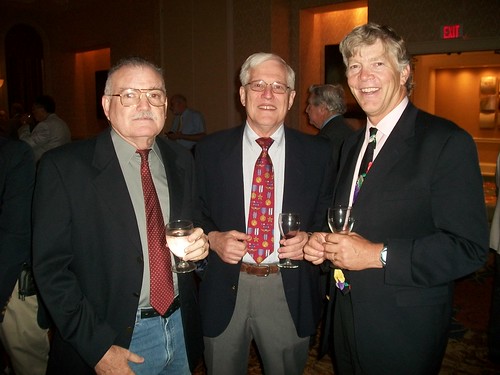
NUMISMATIC VOCABULARY: POWDER METALLURGY
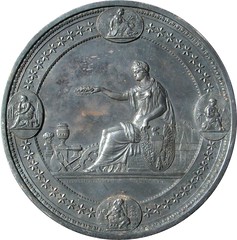

On that Centennial Medal that looks like it started with pellets of metal--it probably was. The process is called Powder Metallurgy, and is a fairly common but specialized metallurgical process. Here is the introduction from the article on that process as presented in Wikipedia, followed by the web link. The article is pretty good at explaining the whole process, so no need for me to re-type it.
"Powder metallurgy is the process of blending fine powdered materials, pressing them into a desired shape or form (compacting), and then heating the compressed material in a controlled atmosphere to bond the material (sintering). The powder metallurgy process generally consists of four basic steps: (1) powder manufacture, (2) powder blending,(3) compacting, (4) sintering. Compacting is generally performed at room temperature, and the elevated-temperature process of sintering is usually conducted at atmospheric pressure. Optional secondary processing often follows to obtain special properties or enhanced precision."
It is possible that the medal was formed directly by a powder metallurgy process, or that the blank planchet was formed by powder metallurgy and then the planchet was struck in the normal way. Close examination would reveal the approach used. If you want a more detailed technical description, see: en.wikipedia.org/wiki/Powder_metallurgy
To read the earlier E-Sylum article, see: QUERY: HOW WAS THIS CENTENNIAL EXHIBITION AWARD MEDAL MADE? (www.coinbooks.org/esylum_v15n42a14.html)
RESEARCHER SEEKS FIRST LIST OF MEDALS FOR SALE BY U.S. MINT
It is well documented when the Philadelphia Mint established a "Medal Department" for the sale of national medals to the public. This was in February 1861 despite the fact collectors had been buying such medals long before that date.
Bob Julian relates that 16 New York City numismatists wrote a letter to Mint Director James Ross Snowden on January 17, 1861 to establish such a department. Snowden acceded to their demand. [Page 26, Introduction, Medals of the United States Mint.]
This formalized selling national medals to anyone who desired to acquire these.
My question is: How did the public learn what medals were for sale? How were the medals publicized?
We know that later these were offered for sale by mimeographed lists, listing medal name, composition, size and price. These were sent by the Mint to anyone who requested. (As a teenager I did just that, but the list was such apparent ephemera that it has long since disappeared.)
In fact, all medals offered for sale by the U.S. Mint are referred to as List Medals because of these former mimeograph sheets. The practice halted in 1969 when all the national medals for sale were published in the Failor and Hayden book "Medals of the United States Mint."
So these mimeograph lists could have been issued intermittently from 1861 to 1968. If they are not dated it can be easily determined by the latest presidential medal listed.
Second question: When was the first such list issued? Third question: Who was the first person to use the term "list medals" for these medals?
If you own one kindly email me the apparent date. Thanks. dick.johnson@snet.net
1812, 1813 AND 1815 NAVAL MEDALS SOUGHT FOR EXHIBIT
We are seeking for purchase 20th Century replicas for the 1812, 1813 and 1815 NAVAL Medals struck by the US Mint for an exhibition at a San Francisco Museum display in 2013. There are about 13 unique or novel reverse types depicting the naval engagement for which the naval hero was honored.
To date, we have six of the novel reverse types. Presently we are short seven of the novel reverse types. Thus, our WANT LIST includes the medals for:
- Decatur
- Bainbridge
- Lawrence
- Burrows/McCall
- Stewart
- Biddle, and
- the medal struck by the US Mint for the Government of PA for Perry
The local coin club in SF has been asked to assist in this effort.
So if E-Sylum Readers have these medals for sale, or know of someone who does, we would very much appreciate their help as we are on deadline.
Charley Marsteller
cm_marsteller at hotmail.com
OCTOBER 2012 CUBAN NUMISMATIC ASSOCIATION NEWSLETTER PUBLISHED
Below is an image of the 1629 relic medal and a Letter to the Editor exchange about a 1957 Cuban commemorative. -Editor
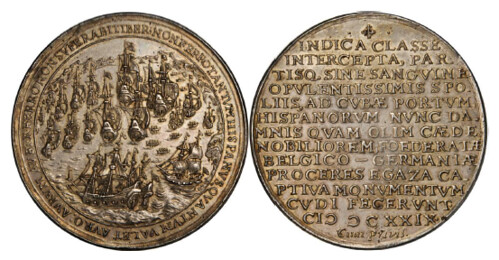
1629 Matanzas Relic Silver Relic Medal
Reader M.J. sent the following email:
Can you tell me anything about a Cuban Gold Commemorative coin, which reads 1856-1857 Congreso Constituyente on the back, and Primer Centenario De La Constitucion De 1857 on the front?
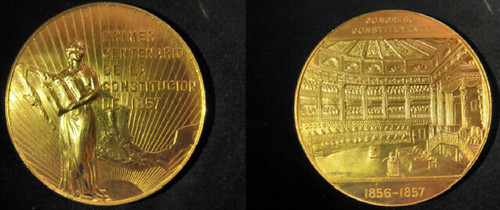
Editor Frank Putrow replied:
EDITOR: Thank you for the email regarding the Gold Commemorative. Actually, it is a Mexican coin. There is not much information on the coin in the reference books, but I think I have discovered what you are looking for. It is gold, .9 in purity. It weighs 41.6666 grams, or 1.2 ounces. They were minted in 1957 to commemorate 1857 Constitution. The Krause World Coin Catalog of World Coins lists the coin in the Medallic Gold Coinage Section, as KM # 122a. It also estimates the value as $2150 in bright uncirculated (BU) condition. I found 2 examples on the internet, with prices from $2000 to $5600. The latter was packaged in 1957 (anniversary) in a beautiful satin box, and was in BU condition.
For more information on the Cuban Numismatic Association, see: www.cubannumismaticassociation.com
WAYNE'S NUMISMATIC DIARY: OCTOBER 14, 2012
The Writer's Almanac for October 9th stated:
In 1888 on this day, the Washington Monument was opened to the public. In 1848, at a Fourth of July ceremony, the cornerstone of the monument was laid. Lack of funds and continued interruptions delayed completion until its completion and dedication on February 21, 1885. The 555-foot structure opened officially to the public on October 9, 1888. By the day of the grand opening, the monument was outfitted with a steam-powered elevator that took 10 or 12 minutes for the trip up and down. At the time, it was the tallest building in the world. In the first nine months, more than 600,000 people visited, and by the turn of the century, more than 1.5 million had come.
I passed this factoid on to Eric Schena, who adds:
Another fun fact: at the time of completion, the aluminum "topper" was the single largest piece of cast aluminum.
As it happened, October 9th was the meeting of my monthly numismatic social group, Nummis Nova, and by happenstance we were meeting at The Mount Vernon Inn at George Washington's estate near Alexandria, VA.
Eric and I made plans to play hooky from our respective jobs to get there a little early and visit the museum. Steve Bishop also joined us - he was already waiting when I arrived. I poked around the gift shop while we waited for Eric. I purchased two sets of replica currency - the quality seemed very high and the price a bargain. I plan to donate them as auction lots for the next local coin show kid's event, although truth be told, I wouldn't mind keeping them for myself. One packet is a group of 10 continental Current notes, and the other has thirteen state notes, one from each original colony, a tough set to complete for real.
When Eric arrived we made our way to the ticket window. As it happened, going late afternoon midweek in October is a fine way to avoid crowds - there were only four people ahead of us, and the whole place looked deserted. We got a timeslot for the very end of the day, and would be able to visit the mansion as well as the museum if we hurried. So we rushed to the visitor center/museum first.
I don't know if Steve ditched us or we ditched him, but we got separated in the visitor center. Eric and I walked thru the museum together. Right in the main entrance stands Houdin's iconic bust of Washington on a pedestal, behind glass. It was a delight to finally view this work in person. I have on my desk at home a reproduction modeled after Houdin's bust, which the Washington family felt was his most accurate likeness.
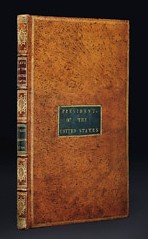 To the left was an alcove displaying Mt. Vernon's most recent acquisition - George's Washington's leatherbound copy of the Acts of Congress, given to him by Congress and annotated in his own hand. The volume was purchased in a Christie's auction earlier this year and donated to Mt. Vernon. It was here that we learned from the guard that all the construction next to the parking lot is for the new Washington Presidential Library. I couldn't remember the hammer price, but the guard told Eric is was about $9 million.
To the left was an alcove displaying Mt. Vernon's most recent acquisition - George's Washington's leatherbound copy of the Acts of Congress, given to him by Congress and annotated in his own hand. The volume was purchased in a Christie's auction earlier this year and donated to Mt. Vernon. It was here that we learned from the guard that all the construction next to the parking lot is for the new Washington Presidential Library. I couldn't remember the hammer price, but the guard told Eric is was about $9 million.
Around a nearby corner Eric pointed out his favorite sign - it read, "Please Do Not Photograph the General's Dentures".
I noted several of the numismatic items on display:
- A 1768 Mountain Road lottery ticket with Washington's signature
- Continental Currency: a 1776 $7 note and an 1778 $60 note
- A Jacob Perkins Funeral Urn medal
- Five Inaugural buttons c1789
- An insignia of the Society of the Cincinnati (an early 19th century replica)
- An Indian Peace medal on a beaded necklace
- A die for a Presidential Seal, similar to the Great Seal of the United States, engraved by Robert Scot
Some of the non-numismatic items I found interesting were:
- Washington's sundial
- The original Mt. Vernon weathervane
- A fire bucket circa 1789
- A coffin handle
- The printing plate for a dinner invitation from the President and Mrs. Washington c1790
One item that is sometimes seen in auctions of colonial numismatic items is a gorget. On display was a c. 1776 gorget of Alexander Hume with the motto & emblem of the 2nd South Carolina regiment. "Gorget" is such an obsolete term that my spell checker doesn't even know it. I've seen definitions such as "a piece of armor for the throat" or "a crescent-shaped ornament". Can anyone more familiar with colonial garb tell us more about gorgets and any numismatic connections?
We raced out of the museum to get to the mansion for our tour, taking some pictures along the way. Once inside we caught up with Steve Bishop. It was an enjoyable and quick tour, with few other tourists ahead of us.
Here are Eric's thoughts on our visit. He writes:
I am really glad we could at least tour a little bit - wish I had gotten there sooner. The artifacts in the galleries were great: I particularly enjoyed seeing included the Indian Peace medal with the necklace - I have only seen photos or reproductions of them and I have never seen one with the necklace. To see an original in person, albeit with glass in between me and the artifact, was particularly meaningful.
Another item I really liked seeing in person was the c. 1831-1832 French made Order of the Cincinnati badge in gold. Of all the society badges in the US, I have always thought the Cincinnati badge was the most beautiful, but I have again only seen later versions.
One thing I particularly liked about going when we did was being able to photograph the house with no one standing in front - with such a huge landmark, opportunities like that are few and far between. And to think that I lived within 10 minutes of there for many years at one point and never saw any of that...
I made a stop at my car to pick up the magnifier I'd forgotten. In the parking lot I ran into Dave Schenkman and we walked together to the restaurant. Gene Brandenburg was waiting out front. When we walked in it was easy to tell Gene and Dave had been here before. Elsie, one of the waitresses, gave Gene a hug. They were quite the odd couple, looking like Archie Bunker and Louise Jefferson dancing cheek-to-cheek. Gene told everyone, "she's my ex-wife!" She gave Dave a hug next, and he said, "she's MY ex-wife, too!"
We made our way over to our usual table. Other attendees were Brian Cushing, Jon Radel, Mike Packard, Julian Leidman and Tom Kays. Ron Abler and Joe Levine each had to cancel for personal reasons. Gene wasted no time in ordering his favorite menu item, the Hoe Cakes.
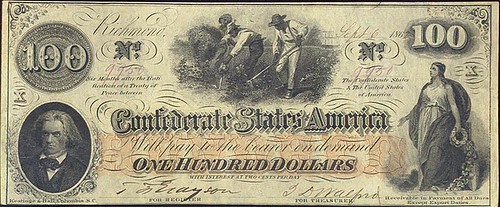
 Because of the fall season our theme was "colors", and several attendees passed around some nicely toned coins and medals. My favorite was Steve Bishop's Morgan dollar. Gene had four well-worn colonial coppers including two Fugio cents. He also showed off a nice group of banknotes including a set of consecutively numbered 1862 Confederate $100 bills, all with three interest stamps on the back, including the rare 1865 stamp. He sent me these images for The E-Sylum.
Because of the fall season our theme was "colors", and several attendees passed around some nicely toned coins and medals. My favorite was Steve Bishop's Morgan dollar. Gene had four well-worn colonial coppers including two Fugio cents. He also showed off a nice group of banknotes including a set of consecutively numbered 1862 Confederate $100 bills, all with three interest stamps on the back, including the rare 1865 stamp. He sent me these images for The E-Sylum.
Dave Schenkman had several recent purchases as well, and he sent in images of a couple of them, both Bolen tokens. The Pioneer Base Ball Club token is the earliest known baseball token. The second piece, appropriately, has a Washington portrait on the obverse.
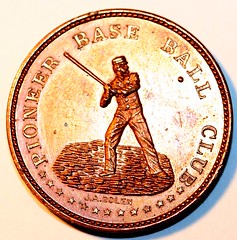

Pioneer Base Ball Club, Springfield, MA

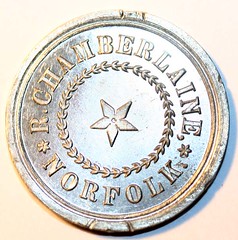
Dave writes:
The Virginia token is white metal (tin, as Merriam called it) and is a mule with a Bolen die. Only five struck, per Musante. The Pioneer Baseball Club piece is Bolen’s first work, as I recall. 75 struck in copper and 125 in white metal.
Eric Schena wrote up this description of an item he exhibited, a stock certificate with a connection to Washington (see below image):
I brought it since the New Shenandoah Co. was a successor to the Patowmack Company, which George Washington served as its first president. The New Shenandoah Company was established by the Virginia General Assembly in 1814 to take over making navigation of the Shenandoah River possible from the Patowmack Company. The company built and maintained navigable channels and dams for flat bottomed boats called gundalows starting at Port Republic in Rockingham Co., VA, with a major stop at Front Royal/Riverton and ending at Harper’s Ferry in Jefferson Co., then in VA.
Gundalows were used for only one trip down the river where, after reaching their destination (usually either Front Royal/Riverton or Harper’s Ferry), the boats were broken up and sold for lumber. In 1814, the New Shenandoah Company was granted the right to raise $100,000 by selling shares of stock at $50 per share (with 300 shares being reserved for the Patowmack Company as payment for construction already built/undertaken), however, the few seen examples of the stock certificates all bear the date November 16, 1824 in groups of 5 shares per certificate.
The handwritten notation at right edge (in same hand as S.H. Lewis, company secretary/treasurer) reads: "$50 per share. Transferable by deed on the books of the N S Co." This one was issued to Capt. Isaac Bowman (1757-1826), operator of a flour & grist mill along Cedar Creek just east of Strasburg on the Shenandoah/Warren County line. Originally built in 1792-1793, the mill was in ruins by the 1920s and finally demolished sometime in the 1970s. The mill race now forms part of the main course for Cedar Creek.
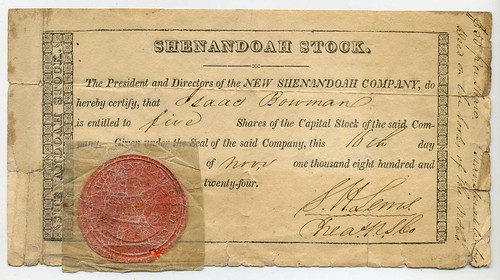
I wish I could show some images of the museum items, but no photography was allowed. I'd written to the curators asking if we could speak with someone, but I didn't hear back until today. I asked about getting some images, so maybe we’ll have some next week.
It was another great evening of numismatic fellowship. These dinners are the highlight of everyone's month, and being able to visit the Mount Vernon museum and mansion made it a really special occasion for me. We broke up around 9:30 or so and I pointed my car toward home. 'Til next month!
To read the complete Writer's Almanac on the web, see: The Writer's Almanac: TUESDAY Oct. 9, 2012 (www.elabs7.com/functions/message_view.html?mid=1593730&mlid=499&siteid=20130&uid=0ce7fb4f1a)
To read the earlier E-Sylum article on Washington's Acts of Congress, see: NOTES FROM E-SYLUM READERS: APRIL 29, 2012: George Washington's Acts of Congress (www.coinbooks.org/esylum_v15n18a16.html)
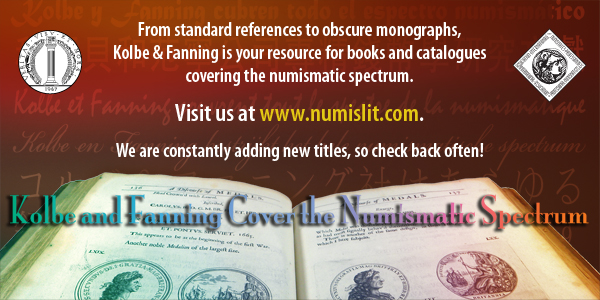
MORE ON WASHINGTON BEFORE BOSTON DIE VARIETY RESEARCH
While on the subject of George Washington, regarding Glenn A. Mooney's pioneering work on the Washington Before Boston medal, John W. Adams wrote:
The quality and thoroughness of Mooney's research is fully up to the standard set by Sylvester Sage Crosby; it is a shame that more people have not read his work. His 1976 paper, though obscure, remains the last word on the subject.
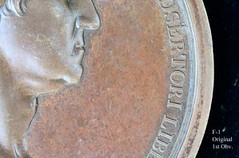 I am happy that my article about the Die Varieties of the Washington Before Boston medal has sent people back to their collections to look at the medals. I hope that more people will report their findings. A die emission sequence can only be theorized and verified by looking at the medals themselves.
I am happy that my article about the Die Varieties of the Washington Before Boston medal has sent people back to their collections to look at the medals. I hope that more people will report their findings. A die emission sequence can only be theorized and verified by looking at the medals themselves.
John Adams’ recent report in the Esylum newsletter of October 7, 2012 that there are examples of F1 "that are from a later obverse die state than most of the F-2’s and F-2.1’s" would certainly make sense and would be consistent with my study. The error reverse, F2 and the corrected error reverse, F2.1 did not experience much use. There are only 4 known error reverse, F2 (Scarinci, Menchell, Adams have 3 of the 4) and no more than 8 or 10 corrected error, F2.1 (Menchell & Adams account for 2 of them). The corrected error reverses, F2.1, that I have seen, all show die failure. It is certainly possible that the Paris Mint reverted back to using the original broken reverse after the failure.
If John Adams’ observations are correct then collectors who own original F1 Washington Before Boston Medals need to carefully examine them. Early die states would be more desirable because they are more likely to have been struck closer to the time of George Washington’s gold presentation medal. The gold presentation medal is the earliest state of the original obverse die.
To read Scarinci's blog article, see:
Washington Before Boston Medal: A Die Emission Study Requires Direct Observation of the Medals Themselves
(donaldscarinci.com/washington-before-boston-medal-a-die-emission
-study-requires-direct-observation-of-the-medals-themselves/)
Scarinci adds:
John Adams has made some excellent observations about the original Washington Before Boston medals, F-1, the error reverse medals, F-2 and the corrected error reverse medals, F-2.1. The total surviving examples of these varieties combined is not estimated to exceed 60 specimens and the correct total is probably a lot less. Therefore, creating an accurate census and recording the die state of these medals by their current owners will result in a tremendous leap in our knowledge about them. It is fitting that John Adams has taken the lead in this and I hope other owners will weigh in as well with their observations. Pictures would obviously be even better..
I have posted enlargements of the key diagnostic area for determining the first obverse die state as well as some additional information on my blog. If you own an F-1, F-2 or F-2.1, please take a look at my blog and contact me with any information that you can share. I am also eager to learn who owns the fourth of the four known error reverse and the other six of the eight or ten known corrected error reverses so please let me hear from you.
With respect to John's comments about Mooney and about the collateral material such as the BPL cliche and the ANS shells, I don't believe these things are at all relevant to a die emission study. As to Mooney's dated article, it is an extraordinary piece of scholarship and it is extremely rare as a piece of numismatic literature. However, it may well be ground zero for much of the confusion that exists about the Washington Before Boston medal. I think that if you own this article, it deserves a place in your numismatic library next to a first edition of Breen's Encyclopedia but it is no substitute for direct observation of the medals themselves.
To read the earlier E-Sylum article, see: MORE ON WASHINGTON BEFORE BOSTON MEDAL VARIETIES (www.coinbooks.org/esylum_v15n42a09.html)
BRITISH MUSEUM VOLUNTEERS PHOTOGRAPH AMERICAN COINS AND MEDALS
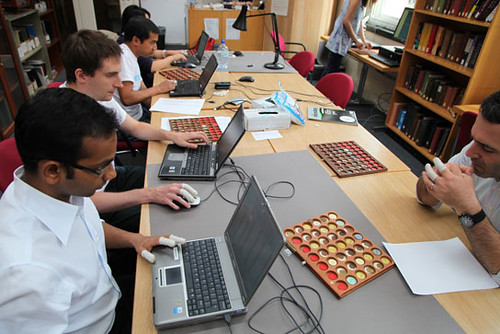
The Department of Coins and Medals at the British Museum has a collection of around a million objects – coins, paper money, tokens, credit cards, and other money-related objects, as well as medals and badges. Any objects going on display – including the more than 1,000 objects in the new Citi Money Gallery – need to have been photographed beforehand for our records. But, we’re also working to create images of as many of the objects in our collection as possible, to upload to our collection online.
Working on this database is a hugely important part of the day-to-day work of curators at the Museum, since the better the records and images available online, the more people can access and study our collection, from anywhere in the world.
Recently, we were helped in this task by some volunteers from Citi, who each gave up a day of their time to do what curators sometimes think is a rather boring task: individually photographing both sides of large numbers of objects.
Yiting Shen, co-chair of the Citi London Volunteer Council, explained that voluntary work in a museum had long been an ambition:
‘Thinking that even counting the coins (over a million objects) would be fun, we managed to land a project to photograph and scan objects from the American coins and medals collection. A total of 565 objects were scanned and catalogued over the two days between two groups of six volunteers.’
We chose the American tokens for these two days, since Citi are celebrating their 200th anniversary this year, and the bank began – in 1812 – in the then newly-formed United States of America.
To read the complete article, see: Recording, and sharing, our money (blog.britishmuseum.org/2012/09/26/recording-and-sharing-our-money/)
EXHIBIT: THE MEDALLIC ART OF JOÃO DUARTE
The American Numismatic Society is pleased to announce a new exhibit The Medallic Art of João Duarte The Winner of the J. Sanford Saltus Award for Signal Achievement in the Art of the Medal
Portuguese artist João Duarte is the recipient of the Society’s 2011 J. Sanford Saltus Award for Signal Achievement in the Art of the Medal. An Award ceremony, lecture and exhibit opening will be held on 6 November 2012 at the Society. Dr. Maria Rosa Figueiredo, curator at the Museu Calouste Gulbenkian in Lisbon, will speak at the ceremony on the history of Portuguese medallic art and Duarte’s place within it.
Graduated in 1978 from the Escola Superior de Belas-Artes de Lisboa, with an emphasis in plastic arts and sculpture, Prof. Duarte serves on the fine arts faculty of the Universidade de Lisboa. Over the course of a highly prolific career, he has focused his energies primarily on sculpture and medallic art, producing 45 public art monuments located throughout Portugal and a dozen commemorative coins for the Portuguese Mint. But it is the 150 or so medals he has created to date that have most caught the eye of critics, collectors, and curators, earning him a number of prestigious awards already, including the Calouste Gulbenkian Foundation Prize for Innovation and Creativity (presented at the 28th FIDEM congress in 2002). Duarte’s medals have been featured in over a dozen solo-artist shows, including an important a 30-year retrospective of his work held in 2010 at the Portuguese Mint. This retrospective documented not just the evolution of Duarte as an artist, but also his critical role in the continuing development of the art medal in Portugal.
The genius of Duarte’s work, in part, lies in his keen awareness of the long tradition of the medal, from its numismatic origins in 15th century Italy to its post-WWII sculptural permutations. Not one to always abandon traditional aspects of the medal—its circular shape and use of legends, for example--he recognizes the essential strengths of the inherited format, but moves well beyond its limitations. Key to his vision is an understanding of the traditional medal as handheld art, and the ways in which the viewer—or holder—interacts intimately with the object in hand. While generations of connoisseurs have delighted in the visual details of medals and the tactile pleasures of heft and high relief, any such enjoyment is ultimately passive. Duarte’s work, by contrast, invites viewers to be more active: many of his medals can be disassembled, many have moving parts, some of which produce sounds, adding a whole new sensory range to the experience of the art. Manipulating and listening to the medals become as much a part of the experience as simply holding and looking. Consequently, Duarte’s medals really demand to be held since full appreciation of the objects cannot be obtained by simply looking at them behind glass. A number of Duarte’s medals in the ANS collection will be on display in the Society’s gallery from 6 November 2012 to 15 March 2013.
6 November 2012 5:30 pm Reception and exhibit opening 6:00 pm Award Ceremony & Lecture For More information or to RSVP contact Joanne Isaac at 212-571-4470 ext. 112 or ANS@numismatics.org
To read the complete press release, see:
The Medallic Art of João Duarte
(numismatics.org/wikiuploads/NewsEvents/2012_1012
PR_Duarte_SaltusAwardampexhibit.pdf)
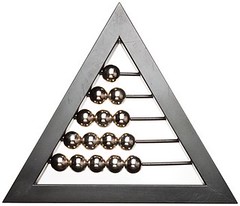
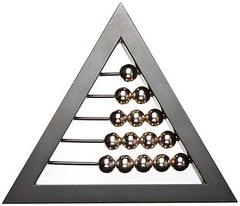
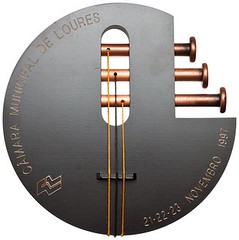
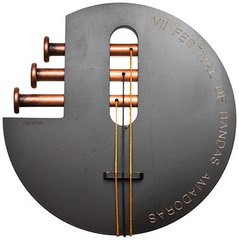
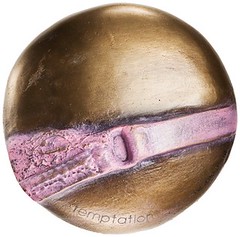
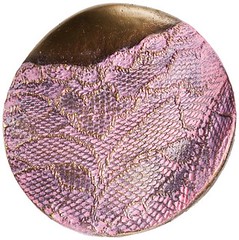
For more information, see the online exhibit: The Medallic Art of João Duarte (numismatics.org/Exhibits/DuarteExhibit)
FUNDING THE WAR OF 1812
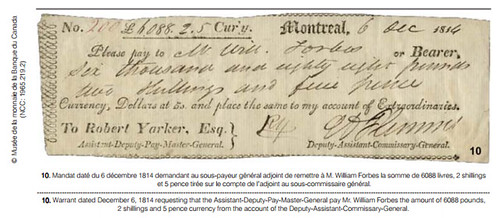

To read the complete issue, see: Moneta September 2012 (http://www.ons-sno.ca/Moneta_2012_09_PV.pdf)
SOME NEW COIN ISSUES: OCTOBER 14, 2012
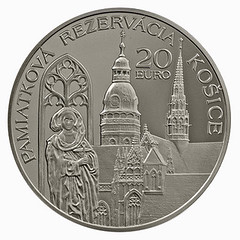
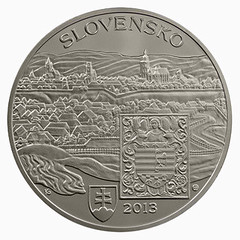
Slovakia 20 euro on "Conservation Area of the Košice Town"
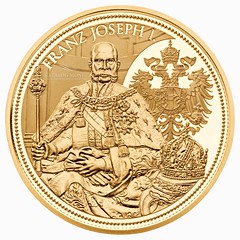
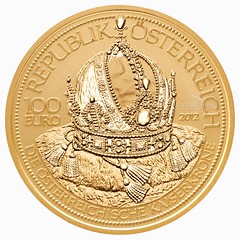
Austria 100 Euro gold coin to commemorate the Austrian Crown
KEY THALER FIGURES: ARCHDUKE SIGISMUND AND BERNHARD BEHEIM
Ursula Kampmann prefaced the issue with this note:
Our whole team is on its way to Hall in Tyrol. If you have never been to Hall you absolutely should go there one day. Hall is not only one of the most charming mediaeval towns in Austria, in addition it played a decisive role in Europe's and even the World's numismatic history. It was there where the thaler was invented (although, at this time it was still called guldiner) and where for the very first time coins were minted on a grand scale by a machine. Today, Hall has an excellent coin museum that was created by a couple of very committed numismatic enthusiasts who have been developing the museum ever since.
On Friday, Hall is going to house a colloquium on the mint's relevance to the history of European coinage. Though there should be another colloquium on how a small conspired community of coin enthusiasts can succeed in turning a town into a centre of numismatics.
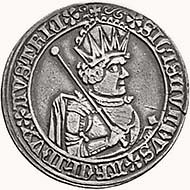 The date was February 7th, 1496. Columbus hadn’t returned from his second journey yet, in the realm of the Holy Roman Empire everyone was upset about general taxation which had been decided at the diet at Worms one year ago, and the Syphilis which had been introduced from America spread all over Europe. Much happened those days indeed; and in a secluded chamber in the Innsbruck Residence a lonely man laid dying.
The date was February 7th, 1496. Columbus hadn’t returned from his second journey yet, in the realm of the Holy Roman Empire everyone was upset about general taxation which had been decided at the diet at Worms one year ago, and the Syphilis which had been introduced from America spread all over Europe. Much happened those days indeed; and in a secluded chamber in the Innsbruck Residence a lonely man laid dying.
Archduke Sigismund of Tyrol, master of the then most profit-yielding silver mines of the world laid on his deathbed. He had huge reforms carried out in the European coinage. On his order the pfundner was struck, the sechser, the half guldiner and the guldiner which was to become model of all talers. Finally, on his deathbed, the archduke expressed one last wish: he wanted to dig his hands into coins, to feel the cool metal on his skin one last time. Sigismund asked his financial administrators to bring two pots with coins.
The legend of the dying archduke wishing to cool his hands on coins is a belated invention. What really happened may be gathered from a chronicle which reports for March 6th, 1496:
One has assembled (around his deathbed, author’s note) three basins with money, one with gold, the other with new sechser, the third one with new kreuzer. Likewise donation with sechser given to poor people.
Sigismund continued to be the prodigal to the last who didn’t spend his money on his country’s structural improvements but rather gave it to those standing face to face to him to make them happy.
To read the complete article, see: Why Sigismund ‘rich in coin’ died a destitute man (www.coinsweekly.com/en/Why-Sigismund-rich-in-coin-died-a-destitute-man/8?&id=8&type=a)
Today’s visitor of the Hall parish church has two options for entering the churchyard. In case he chooses the portal which leads him directly from the town square to the church he immediately discovers, to his left near the church yard’s wall, the tombstone of a man who, in his function as mint master, accompanied one of the most important revolutions in minting.
It was under Bernhard Beheim the Elder, whose tomb so many tourists of the city of Hall pass without taking further notice, that the first guldiner were minted, the big silver coins that were issued by Duke Sigismund Rich in Coin who had silver in abundance. These pieces with their weight being related to the gold gulden, whose silver equivalent they were designed to be, became the predecessor of the most common trade coin of early modern times, the taler.
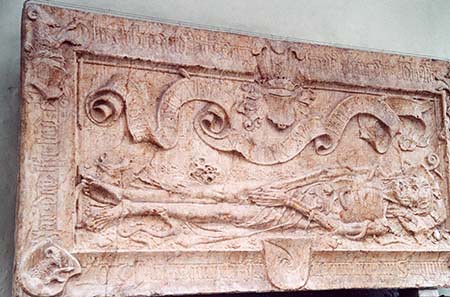
His tomb shows Bernhard Beheim in the style of the Renaissance, in a sheer garment, his halfway rotten body eaten up by bugs, snakes, toads and snails. This pitiful representation was considered appropriate by early modern artists to visualize the horror of death and to state the human body gets into after death, in contrast to the undying soul. To the modern viewer that may seem odd since the sepulchral marker hardly betrays what important man it covers.
To read the complete article, see: What is left of the man who invented the taler (www.coinsweekly.com/en/What-is-left-of-the-man-who-invented-the-taler/8?&id=92&type=a)
MARTIN PURDY ON THE HO HI WHANG TOKEN MYSTERY
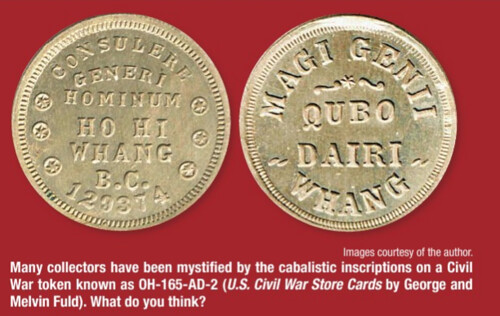
Some thoughts on the mystery "Chinese" item in last week's E-Sylum, just by way of adding to the brainstorming - I don't pretend to have resolved the question of what it is!
As far as I can make out, CONSULERE GENERI HOMINUM means "look after the interests of mankind" (Consulere + a noun in the dative case means "study the interests of, provide for, promote the welfare of", according to my old Latin dictionary, Generi is the dative form of Genus (kind, type), and Hominum is a plural genitive ("of men") - genus hominum seems to be a compound expression meaning "mankind".)
MAGI GENII also seems to be a genitive ("of the magic spirit" - someone else with better Latin than mine may pick better words, but that's the idea), or it could be a simple plural ("magic spirits"). It doesn't seem to tie in with anything else on the token. But then all of the elements on it seem to be in isolation anyway. The words themselves could be in isolation, too - THE MAGI and SPIRITS/DEITIES.
B.C. - I think it's a stretch to assume this refers to a date (BC normally comes after the numerals, just as AD precedes them in correct usage), especially in the context of a 6-digit number. No possibility of a reference to British Columbia here? Are there Canadian tokens known from that Province in the period in question? Could the numbers be code, or even a registered design number? (I've seen one such on a 1919 'Peace' token that was sold in New Zealand, so the idea isn't totally impossible)
QUBO is weird, but KUBO exists as a Japanese surname, and I actually found a KUBO DAIRI as the name of a holder of various recent patents (individual or company name? Not sure). But someone of the same name appearing on a presumably North American token 120 years earlier? Doubtful.
WHANG is an odd spelling if it's a Chinese name, as has been noted, but then conventions for transliteration would have been less strict at the time. The spelling is still around as a surname, as Mr. Google will confirm.
The idea that it was deliberately conceived to be mysterious is probably the most likely explanation, rather like the assemblage of charms and symbols that one sees on Masonic tokens - if you know what they are, they make sense; if they don't, they're a bunch of symbols.
To read the complete article, see: MORE ON THE HO HI WHANG TOKEN MYSTERY (//www.coinbooks.org/esylum_v15n42a26.html)
COPYRIGHT AND THE NEW ZEALAND HOBBIT COINS
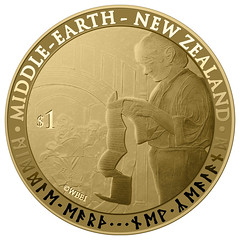 As anticipation for Peter Jackson's latest Tolkien epic "The Hobbit: An Unexpected Journey" reaches a fever pitch around the world, fans in New Zealand will soon be able to use (or just collect) commemorative coins stamped with the faces of Gandalf, Bilbo Baggins and Gollum.
As anticipation for Peter Jackson's latest Tolkien epic "The Hobbit: An Unexpected Journey" reaches a fever pitch around the world, fans in New Zealand will soon be able to use (or just collect) commemorative coins stamped with the faces of Gandalf, Bilbo Baggins and Gollum.
The coins, some of which will be minted from pure gold, will be legal tender in the country, although their face value (ranging from NZ $1 to NZ $10) will be only a fraction of what they'll go for, AFP notes. (The most expensive coin, made from one ounce of pure gold, retails for NZ$3,695, or $3,020 in U.S. dollars.)
The coins, which will be released on Nov. 1 in advance of the movie's Nov. 28 premiere, are being minted by the New Zealand Post "to mark this moment in cinematic history." They are, according to the Post, "the only official legal tender commemorative coins from Middle-earth."
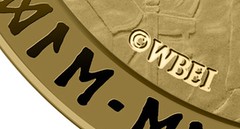 OK, here's a close up. It's hard to read, but I think it's a copyright symbol and the letters WBEI, which I guess stand for Warner Brothers Entertainment Inc. The copyrights for the film and characters of Tolkien's Lord of the Rings series are owned by Warner Brothers. Is this the first coin to include the copyright symbol? What exactly does this mean - could Warner Brothers hassle numismatists for publishing images of the coins? Now that they're publicizing the film they certainly want as many outlets as possible to mention it, but will there be trouble further down the line?
-Editor
OK, here's a close up. It's hard to read, but I think it's a copyright symbol and the letters WBEI, which I guess stand for Warner Brothers Entertainment Inc. The copyrights for the film and characters of Tolkien's Lord of the Rings series are owned by Warner Brothers. Is this the first coin to include the copyright symbol? What exactly does this mean - could Warner Brothers hassle numismatists for publishing images of the coins? Now that they're publicizing the film they certainly want as many outlets as possible to mention it, but will there be trouble further down the line?
-Editor
To read the complete article, see:
Hobbit Currency To Be Legal Tender In 'Lord Of The Rings'-Obsessed New Zealand
(www.huffingtonpost.com/2012/10/10/hobbit-currency
-legal-tender-in-lord-of-therings-obsessed-new-zealand_n_1955717.html)
LARGE BATCH OF NEW $100 BILLS STOLEN
 The FBI is reporting an unusual heist of some newly designed $100 bills that aren't going into circulation until next year.
The FBI is reporting an unusual heist of some newly designed $100 bills that aren't going into circulation until next year.
Agent Frank Burton Jr. says the cash was stolen from a plane that arrived at Philadelphia International Airport around 10:25 a.m. Thursday from Dallas.
Investigators said these Benjamins are easy to spot. The new bills have sophisticated elements to thwart counterfeiters, like a disappearing Liberty Bell in an orange inkwell and a bright blue security ribbon.
The FBI said a "large amount" of bills were stolen, but agents aren't giving specifics.
The theft was reported by a courier service transporting the C-notes when the shipment arrived Thursday afternoon at the Federal Reserve Building in East Rutherford, N.J. Officials then discovered some of the money was missing.
To read the complete article, see: FBI: 'Large Amount' Of Newly Designed $100 Bills Stolen At Philadelphia International Airport (www.huffingtonpost.com/2012/10/12/fbi-one-hundred-dollar-bills_n_1962702.html)
AN ABANDONED ATTIC FULL OF BOOKS
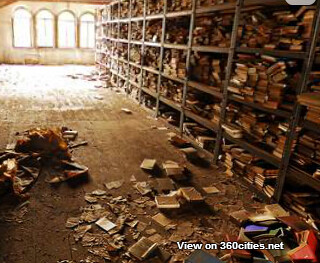
"Because there aren't enough things to be sad about in the world. Behold, a once-glorious attic full of books falling victim to entropy and vandalism. I don't know the real story behind this, but I know a sad sight when I see it."
To read the complete article, see: Panorama of a despoiled library (boingboing.net/2012/10/11/panorama-of-a-despoiled-librar.html)
FEATURED WEB SITE: TOKENCATALOG.COM
This week's Featured Web Site is Richard Greever's site, www.tokencatalog.com
The tokens you see on the TokenCatalog.com site ARE FOR REFERENCE ONLY. THEY ARE NOT FOR SALE. They have been contributed by many individuals and most are held in private collections. We are simply trying to share information about these tokens.
All visitors are welcome. Everyone can access the Catalog as a Guest, you can go directly to the Display Tokens page. If you collect tokens and like what you see, please register. Registration allows me to know how many different people are using my website and allows you to make contributions to the database. If you want to help with this project, have questions or comments, I would love to hear from you. I need images of any token missing from the catalog. Contributions from all states are welcome. Together we can make an awesome catalog.

www.tokencatalog.com

